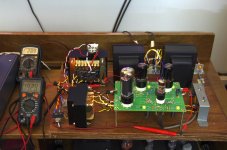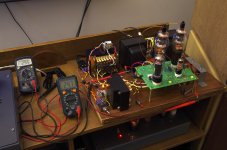Hi,
After the TSE-II I want to start the SSE. The builds will accommodate various tubes with switchable cathode bias.
The first build is 275v secondary for 6V6, 807 & 6P3s. The second build is 375v secondary for 6L6GC and EL34. The mains trafo is a local build and OPTs are Edcor CXSEs.
With SS (OnSemi RHRP15120) can I install two thermistors - one at the mains fuse and another before the SS diodes? Does this make sense to delay the B+ ?
CL60 (10R) - Mains input
CL140 (50R) - Secondary center tap
Thanks.
sunil
After the TSE-II I want to start the SSE. The builds will accommodate various tubes with switchable cathode bias.
The first build is 275v secondary for 6V6, 807 & 6P3s. The second build is 375v secondary for 6L6GC and EL34. The mains trafo is a local build and OPTs are Edcor CXSEs.
With SS (OnSemi RHRP15120) can I install two thermistors - one at the mains fuse and another before the SS diodes? Does this make sense to delay the B+ ?
CL60 (10R) - Mains input
CL140 (50R) - Secondary center tap
Thanks.
sunil
SSE 275/300
Got my first SSE running. Reading the adventures of others, decided to try a dual secondary and have switchable 275 /300. The cathode bias is 'toggled' via that contraption on the right side 😀
This one is running at ~ 290v /20v with 560R on Rk. The valves are 5U4Gb, Brimar 12AT7 and 6P6S.
Any recommendations on what voltage I should run this? The spec sheet says its a 13w tube, so I can raise the secondary or drop Rk to 400R.
Got my first SSE running. Reading the adventures of others, decided to try a dual secondary and have switchable 275 /300. The cathode bias is 'toggled' via that contraption on the right side 😀
This one is running at ~ 290v /20v with 560R on Rk. The valves are 5U4Gb, Brimar 12AT7 and 6P6S.
Any recommendations on what voltage I should run this? The spec sheet says its a 13w tube, so I can raise the secondary or drop Rk to 400R.
Attachments
Congrats Sunil, very neat breadboard build.
On the page with sims here, George says:
That's a good first step. After that, if you want to choose a different harmonic profile, you can use the table and an online parallel resistor calculator to find the value for a couple of matched resistors that you can solder in parallel to the 560R.
Looking forward to seeing your final build in a case, etc...
On the page with sims here, George says:
If you already have transformers from another project I have included these amplifier simulations done with TubeCad SEamp Cad to give you an idea of where to start. Choose an output tube, and find the appropriate table. Then find the B+ voltage and load impedance that most closely matches the transformers that you have. You can then choose a cathode resistor value for a given amount of tube dissipation.
That's a good first step. After that, if you want to choose a different harmonic profile, you can use the table and an online parallel resistor calculator to find the value for a couple of matched resistors that you can solder in parallel to the 560R.
Looking forward to seeing your final build in a case, etc...
Thanks YashN. I'm following G.As recommendations as much as possible. Being a new build the 6P6S was the guinea pig (no magic smoke yet) but the results sound 5hiT.
The amp is wired in Triode and I've tried with valve and SS - B+ (R4) at 290, 320 & 360v. Just couldn't get decent sound. Don't have the equipment to test distortion or anything as such, so can't say what power levels they were at.
Plugged in a Brimar 807 today - 294, 25v and 680R. Sounds the best I've heard so far 🙂
I'll try different power levels and see how it goes. G.A mentioned if the B+ was kept below 375v it should be ok.
Any recommendations from folks who've tried the 807?
The amp is wired in Triode and I've tried with valve and SS - B+ (R4) at 290, 320 & 360v. Just couldn't get decent sound. Don't have the equipment to test distortion or anything as such, so can't say what power levels they were at.
Plugged in a Brimar 807 today - 294, 25v and 680R. Sounds the best I've heard so far 🙂
I'll try different power levels and see how it goes. G.A mentioned if the B+ was kept below 375v it should be ok.
Any recommendations from folks who've tried the 807?
Attachments
I do know that 807 can be a difficult beast to tame, but at the right anode voltage, with the G2 voltage respected, can sound good? It looks like 440v is possible when trdiode wired, from the data sheet. People fit a stopper resistor on the anode cap to help with 'snivets', which may be audible. I have used 5B/255M (807 on a loctal) in a Quad II, and they sound great there, but that is with the benefit of a push pull configuration to improve linearity.
What sound source are you using? It could be that the weakness of that is being exposed?
What sound source are you using? It could be that the weakness of that is being exposed?
807 and 6P3S with Solid state rectifier
The 807s at 294v, 25v and 680R were short lived. The amp started making funny distortion noise. The B+ was rising and the cathode V. was dropping below 19v. While building the 2A3 I had a similar situation while fiddling with the bias pots (~10ma).
Anyway, switched to SS (300v) and this is what I have - 358v, 28v and 560R. Seems to take a while to get going, but after that they sound great.
The 6P3S sounds great at these numbers as well.
Could someone please explain why that happened at 290v 🙂
Thanks George, the flexibility and sound in this design is simply Superb 😀
The 807s at 294v, 25v and 680R were short lived. The amp started making funny distortion noise. The B+ was rising and the cathode V. was dropping below 19v. While building the 2A3 I had a similar situation while fiddling with the bias pots (~10ma).
Anyway, switched to SS (300v) and this is what I have - 358v, 28v and 560R. Seems to take a while to get going, but after that they sound great.
The 6P3S sounds great at these numbers as well.
Could someone please explain why that happened at 290v 🙂
Thanks George, the flexibility and sound in this design is simply Superb 😀
I do know that 807 can be a difficult beast to tame, but at the right anode voltage, with the G2 voltage respected, can sound good? It looks like 440v is possible when trdiode wired, from the data sheet. People fit a stopper resistor on the anode cap to help with 'snivets', which may be audible. I have used 5B/255M (807 on a loctal) in a Quad II, and they sound great there, but that is with the benefit of a push pull configuration to improve linearity.
What sound source are you using? It could be that the weakness of that is being exposed?
Thanks Hector. I'm not messing with the design outside of what we already know and others have tested. The mistakes are what I'm making.
Could someone please explain why that happened at 290v
When the B+ is below about 325 volts the 10K resistors in series with the CCS chips need to be bypassed to provide more voltage to the CCS chip. This can cause distortion as the current through the 12AT7 may be unstable.
I made an SSE using 6V6GT's on 325 volts and the amp sounded better with a piece of wire in place of the resistors. Much below 325 volts and it's probably going to sound really bad.
I decided to complete the 300b into a chassis and think of wiring the SSE in UL. My reference unfortunately is the TSE 2A3 /300b and the SSE in Triode between 300 & 360v doesn't sound right to me.
Solid state and Ultra Linear
UL definitely sounds better than Triode. Way back, w5jag posted a great thread with lots of tubes tested and great info. With SS and 300v secondary I get 360v/30v (680R) on 807 and 350v/29v (680R) on 6P6S.
The 6P3S-e I have are noisy and have a harsh 'in your face' sound. The 807 sounds better than the 6P6S.
With SS, at switch ON, the B+ rises to ~ 410v within 3s while the cathode voltage takes almost 10s to ramp up slowly and then both settle down. Can /should I increase the 10R thermistor in the mains to maybe 50R ? Is this a tricky situation likely to cause problems? Please help.
UL definitely sounds better than Triode. Way back, w5jag posted a great thread with lots of tubes tested and great info. With SS and 300v secondary I get 360v/30v (680R) on 807 and 350v/29v (680R) on 6P6S.
The 6P3S-e I have are noisy and have a harsh 'in your face' sound. The 807 sounds better than the 6P6S.
With SS, at switch ON, the B+ rises to ~ 410v within 3s while the cathode voltage takes almost 10s to ramp up slowly and then both settle down. Can /should I increase the 10R thermistor in the mains to maybe 50R ? Is this a tricky situation likely to cause problems? Please help.
Hi, for SSE builds with B+ less than 300v, the 12BH7 is usually recommended as a fix (with lower gain), will it make a difference using 12BH7A (delayed heater type) ? I can't find any other difference with the 12BH7.
I'm using both valve and SSE rectifier in that build. Any help would be great. Thanks.
I'm using both valve and SSE rectifier in that build. Any help would be great. Thanks.
I think the 'A' postfix, meaning delayed heater warmup, is only a consideration in series heated tubes.
- Home
- More Vendors...
- Tubelab
- SSE build with solid state and valve rectifier

